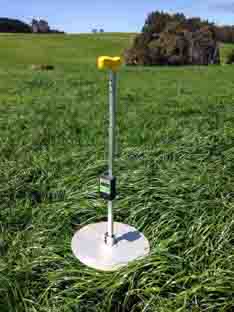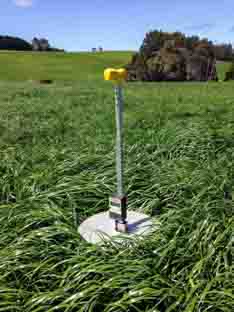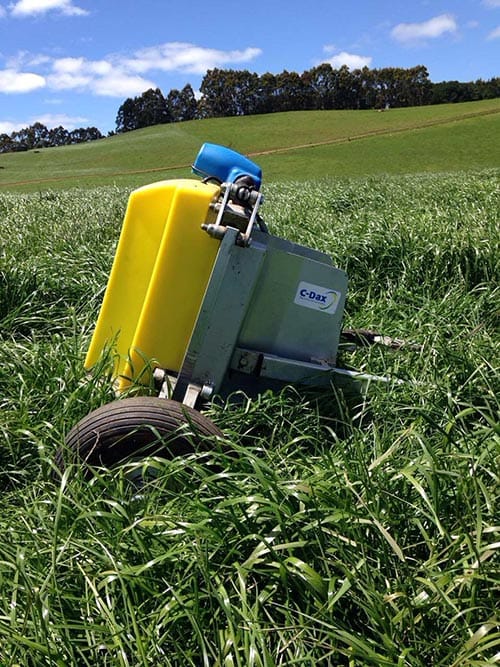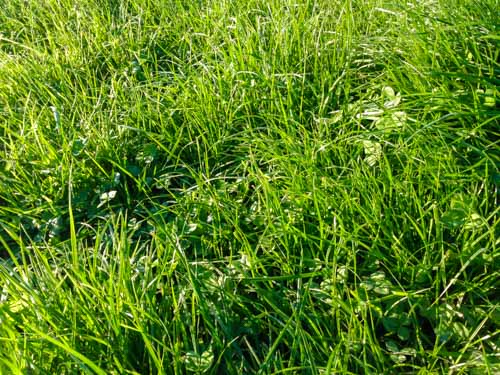Wherever you are in the world...
Imagine your pasture being measured while you're busy farming.
Select a plan today.Say goodbye to regular pasture measurements and...
Say hello to automatic updates of your feed wedge with ZERO labour.
What is a rising plate meter for?
A rising plate meter, also known as a RPM is a tool used to measure the quantity of pasture in a paddock. This reading can inform you of how much pasture you have on hand and how quickly your pasture is growing. It is a fact that farmers will make best grazing decisions when they measure their pastures and their animals will be happier for it.
To use a RPM, you walk across a paddock taking plate meter readings avoiding rough areas that are usually found around gateways, water troughs, pugged areas and near fence lines. The idea is that the walk best represents the paddock you’re measuring. Generally, the farmer walking multiple paddocks at once will plan their route to link up all the paddocks to limit backtracking to save time.

A rising plate meter

A rising plate meter measuring height
How does a rising plate meter work?
When you take a pasture reading, you press the RPM down into the pasture canopy. The RPM then measures the compressed height of the pasture, as the plate rises in half centimetre increments. The compressed height of pasture is then converted into kilograms of dry matter per hectare (KgDM/ha).
It is important to use the most appropriate formula to your farm situation, considering such things as pasture species and whether you irrigate or not. To further limit variability and to maintain consistency with one paddock measurement to another, about 30 to 40 readings across a paddock is required.
How accurate are rising plate meters?
Let’s get one thing straight. It’s not about the accuracy that matters, it’s about the consistency of measuring your pasture covers from week to week, then putting this against what your animals are leaving behind with their post grazing residuals. However, consistency is where the C-Dax trailing pasture meter is leaps and bounds ahead of the RPM. But since you asked, there are many sources of error when using a plate meter, but thankfully, none that can’t easily be overcome:
Operator technique is a big one with plate meters, the idea is to plonk straight down and lift as you walk and not roll the plate. Rolling the plate meter will over estimate cover. If the one-person measures from week to week and knows the proper technique, you’ll be good to go.
RPMs and their equations were initially designed for ryegrass and white clover pastures and not non-ryegrass species such as cocksfoot, tall fescue, and kikuyu. Keep this in mind if measuring non-ryegrass species. In saying this, the ratio of ryegrass to legumes can sway the bias in dry matter estimates. And more with seasonal variation of dry matter %. Ahhh too much to worry about, it’s all about consistency of measuring and monitoring against post grazing residuals anyway.
Rain or heavy dew can weigh the plate on the RPM down, which will cause an underestimation. Who wants to measure when it’s raining anyway?
RPMs start losing accuracy over 3500KgDM/ha when the pasture sward starts leaning over, but these paddocks should be for silage so don’t worry too much.

A C-Dax Pasture Meter
What are the benefits of using a rising plate meter?
Plate meters have been tried and tested for many years now, with strong evidence that supports the use of them for improving pasture management practices. They are one of a range of tools that can be used today, with each tool having their own advantages and disadvantages.
The biggest benefit and perhaps the biggest disadvantage of using a RPM is that you’ll be walking your entire farm regularly. This will provide you with the following:
Close connection with each paddock and how each one is performing – you’ll be a pasture whisperer before you know it.
Regular exercise on-top of your day to day farm fitness regime - who said farmers are lazy?
Time to think about your green pasture and ways to turn it into green notes – where there’s pasture, there’s milk and where there’s milk, there’s money.
You’re a conscientious farmer, right? Well, while you’re walking around you can make notes of jobs that need doing, or better still, do the job such as fix a water trough while on the walk.

A ryegrass and clover pasture
How do different plants effect rising plate meter readings?
Pastures have different levels of dry matter content (DM%) depending on the composition of the sward. On-top of this, the way pastures grow, can change the bias in the plate meter estimates.
Tetraploids Vs diploids
- Tetraploids grow upright and contain slightly less dry matter % than diploids. Diploids also have greater tiller density than tetraploids.
- Verdict: tetraploids will slightly over estimate and diploids will slightly underestimate KgDM/ha
Perennials Vs Italians
- True Italians, annuals and hybrids will grow more upright than perennials.
- Verdict: perennials will slightly under estimate and Italians will slightly over estimate KgDM/ha
- Pastures that are reproductive and contain a lot of seed heads will push the plate of the RPM up, which means the RPM will overestimate the quantity of pasture in the paddock. Other plants such as dock, and herbs such as plantain and chicory (especially with seed heads) will also be a source of error for overestimating pasture quantity.
- Again, these errors can be overcome by knowing your farm and understanding the relationship that your pasture has with its pasture measurements, and that of your grazing animals. We have taken each paddock's individual characteristics right to the nutrition level in Pasture.io, with all the thinking taken care for you so you can relieve precious brain matter.
What are the disadvantages of using a rising plate meter?
Okay, time to face up to it. Although RPMs are a great way to get out and about and have been a trusted tool for ever and a day, there are now better ways of doing the same job. These cons might be alright for some and for others a nightmare, read on if you dare:
Paddock readings need to be manually recorded, thankfully you can tap the amount straight into Pasture.io on the fly.
Error in pasture measuring is never far away due to, well, everything basically. If humans are involved, there is error.
It is slow and time consuming, that feeling of “oh no it is that time again” creeps up awfully quickly, best to employ your most trusted employee to do this job and one that is fit.
In the end, the question prevails, what is your best feed source for feeding your animals? If the answer is pasture, then the advantages of using a RPM far outweigh the disadvantages to using one or not using anything at all.

Ollie Roberts recording a rising plate meter reading
Should I measure my pasture?
If you’re at the end of this page and asking this question, I can see why, it isn’t the most exciting job on the farm to look forward to. But and that is with a capital B, measuring your pasture is one of the most important jobs you can do.
You measure everything else on farm, you measure how much milk leaves the farm, you measure how much fertiliser you apply, you measure how much you spend on labour, you measure everything and pasture is no exception.
Whether you use a tool such as the rising plate meter or some other device, any tool will do provided it’s not your eye. Let’s face it, your eye, as unique as it is, is not the tool to remove any bias, any error and it won’t maintain consistency in measure from one season to another. So, to answer your question, yes you should measure your pasture! And lastly, save your pennies and buy a bike mounted or towed pasture meter, much better and is quicker and more consistent again – but that is for another time.
What are your experiences?
We'd love to hear feedback, or if you have some great tips that we can share in the post above - please feel free to get in touch or leave a comment below.
